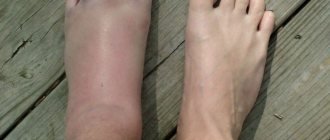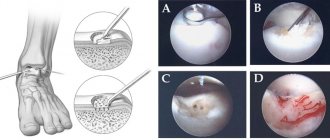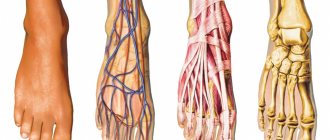Author: Margarita Stogniy
Updated November 8, 2021
Podologist (master of medical hardware pedicure) is a specialist who diagnoses and treats feet and nails. A podiatrist is not a doctor, but he performs medical pedicures aimed at improving the condition of the feet. The profession does not require higher education, but having a medical college diploma will be a plus. By the way, in 2021, the ProfGid career guidance center developed an accurate career guidance test. He himself will tell you which professions are suitable for you, and give an opinion about your personality type and intelligence.
Features of the profession
A podiatrist examines the feet and diagnoses the problem. In some cases, additional examination by specialized specialists is required, because foot problems often indicate the presence of acquired or chronic diseases, as well as inflammatory processes occurring in the body. A podologist diagnoses and eliminates the following problems:
- ingrown nail plates;
- fungal infection of the feet and nail plates;
- inflammatory processes associated with deformation of the nail plates;
- calluses, corns;
- increased sweating;
- cracks on the foot, others.
The forgery may recommend that the client see a doctor, but his competence does not include treatment. We are talking about prescribing medications and procedures; in the case of a serious illness, treatment is carried out by endocrinologists, purulent surgeons, orthopedists and other specialists with higher medical education.
Responsibilities of a podiatrist
Most often, patients who have already undergone diagnostics come to the podiatrist, and a dermatologist or surgeon has come to the conclusion that a specialized specialist can handle such a problem. At the same time, there are quite a lot of responsibilities for a podiatrist, these include:
- conducting a survey;
- referral for analysis;
- carrying out special procedures or operations;
- tracking the recovery process;
- work with medical documentation.
In order to perform the tasks assigned to a specialist, he needs to know:
- anatomy and physiology;
- dermatology;
- anesthesiology;
- principles of surgery;
- pharmaceuticals;
- endocrinology.
Pros and cons of the profession
pros
- To obtain a specialized education, it is enough to complete a course in manicure and pedicure, and then a course in medical hardware pedicure.
- Podiatrists are in demand, because a large number of people suffer from foot problems.
- Podologists work in salons, most often having a separate office, necessary equipment and consumables. Working conditions can be called quite comfortable.
- Decent level of remuneration; specialists often receive tips from clients.
- In the future, you can open your own office.
Minuses
- Podiatrist is not a profession for the squeamish, because clients often suffer from sweating feet, fungus, and unpleasant odor.
- Emotional burnout is possible, because many clients during the procedure share with the master various problems and stories about their lives, which cannot but tire.
- Before working in the field of medical hardware manicure, you must work as a regular master for 1-3 years to gain experience.
Podologist's place of work
A qualified specialist can engage in private practice, as well as work in medical institutions - hospitals and clinics. In this case, it is necessary to pay attention to the fact that a private practice specialist must have an equipped room for performing surgical procedures. And in clinics, the doctor always has an assistant - a nurse.
In general, the working day of a doctor in this category is standardized. And cases with urgent patients are rare rather than a constant occurrence.
Courses
Institute of Podology
The institute has a large number of programs that will allow you to study the intricacies of medical hardware pedicure. Most programs are aimed at specialists who want to improve their skills and gain new knowledge.
School of Podology "MiradaMed"
The school offers basic courses, advanced training programs, and individual programs. Students are trained by specialists with many years of experience; distance learning is possible.
School of hardware pedicure “Podolog”
The school offers a wide range of training programs that will help you learn how to perform regular manicures and pedicures, as well as medical equipment. The programs are aimed at people who do not have knowledge in this area. Under the auspices of the school, master classes can be organized, as well as on-site or individual training.
What does a dermatovenerologist treat?
Modern dermatovenereology is one of the most extensive areas of therapeutic science, and a dermatovenereologist treats diseases belonging to its different areas:
- dermatology – diseases of the skin and its appendages: nails, hair, sebaceous and sweat glands – psoriasis, vitiligo, atopic dermatitis, eczema, alopecia, folliculitis, etc.;
- venereology – sexually transmitted diseases, genital infections and sexually transmitted diseases: syphilis, gonorrhea, molluscum contagiosum, chancroid, herpes, trichomoniasis, mycoplasmosis, etc.;
- mycology – diseases caused by fungi, including candidiasis;
- conservative cosmetology, the goal of which is to improve the appearance of the skin without surgery.
Preventive actions
Like any disease, foot damage is easier to prevent than to treat later. To avoid certain pathological processes, fungal infections, and the development of onychocryptosis, well-constructed prevention is of great importance. In this regard, consultation with a specialist will be extremely useful. Recommendations from a specialist may relate to the following areas:
- special processing of shoes;
- the nature of hygiene measures;
- pedicure techniques;
- use for preventive purposes of products that have a moisturizing, softening, healing, and bactericidal effect.
During the consultation, the doctor will be able to choose suitable shoes for the patient, and will also give qualified advice on nail care and treatment at home in order to avoid foot problems in the future.
Medical pedicure: personal experience
Who needs a medical pedicure and why? Lena Loginova visited a podiatrist and tells what happened. A year ago, a funny story happened to me: my friends and I went to a horror quest, where we had to solve tasks and at the same time fight off actors dressed as monsters. At some point, the monster attacked us quite suddenly, and my friend, weighing a hundredweight, jumped on my leg in surprise. The foot was not happy: several of the toes turned blue, and a crack formed on the big nail.
The leg quickly returned to normal, but the nail continued to crack exactly in the middle. It was uncomfortable: the finger hurt, and an unsuccessful movement could tear off the nail plate. I had to limit myself in sports, and pedicure became something out of the realm of fantasy: any durable coating would come off, taking the nail with it. As soon as the nail grew back and I breathed a sigh of relief, the crack appeared again. Over the past year, it has become clear that this problem will not be solved on its own.
To solve the problem, I went to podiatrist Alena Taranova at the Virsheba hardware cosmetology center. He specializes in dermatology and podiatry: at Bathsheba you can get laser treatments, injections and medical pedicures.
By the way, be careful, the photos below will not be the most appetizing.
No, it’s not them yet -) Podologist Alena Taranova and I
Who is a podologist?
This is a specialist with a secondary medical education who works with problems of the feet and toenails - an intermediate link between a pedicurist and a dermatologist.
You should contact a podiatrist if your nails are coming off or torn off, if they are cracking or growing poorly, if you have severe calluses or hangnails, or if you are the unlucky owner of diabetic feet (diabetics often have poorly healing ulcers). A dermatologist treats skin diseases that require not a one-time treatment, but medication - fungi, eczema, and so on. A pedicurist should work only with healthy nails and refer the client to a podiatrist or dermatologist with any problem.
Why do nails crack?
There are two possible reasons: physiological and mechanical.
Physiological: you have injured the growth zone. Or the nails themselves are thin and fragile, cracking from any impact.
Mechanical: you constantly injure the same place. The reason may be an unprofessional hardware pedicure, which you do from time to time (eating a cactus, in a word -)). Or playing sports during which the toes hit the toe of the shoe: running, badminton, volleyball, basketball, tennis.
What can be the consequences of a cracked nail?
It always seemed strange to me to see a specialist because of a crack in my nail. But if at first it was painless and unnoticeable, then it began to cause pain and limit movement. If you tear off a nail (and I was close to this), then an infection can get into the wound. And now this is already very unpleasant.
What to do?
Stop injuring the nail (if it is due to mechanical damage). For those who run, a life hack from Alena: do not cover your toenails with colored varnish in order to notice the problem immediately when it appears.
If the nail cracks for physiological reasons, this, unfortunately, cannot be prevented. Yes, in a world where people fly into space, it is still unknown how to make it not burst)) But you need to visit a podiatrist regularly to control the situation. And do this when the nail has just started to crack, and not wait, like me, for it to go away on its own. The podiatrist solves the problem symptomatically - trimming it as much as possible and covering it with extension gel (under the coating, the broken part will grow back quietly).. It is important that this is done by a specialist in a clean office: if you get a fungus or infection, they will feel great under the gel.
It would seem that any pedicurist can apply the gel. In fact, yes, my problem was not classified as complex; this is not diabetic foot (trophic ulcers that occur on the feet of diabetics). But not a single pedicurist (and I went to several) could apply gel or gel polish to me without it falling off after a while along with the nail.
Extension procedure
First, Alena examined my feet, noting that the nails were thin and easily bent.
Alena admitted that most often clients come to her with broken nail plates or ingrown nails.
And here come the unappetizing photos
The first thing she did was trim the broken part of the nail and sand it down. This was necessary so that the gel would stick better: it would easily fly off from an uneven surface.
The next stage is the gel. Alena applied three layers, drying each one under an ultraviolet lamp. For me, this was the most unpleasant moment of the procedure: during hardening, the gel heated up and noticeably stung. It’s nice that it turned out to be matte and the nail was visually no different from the rest. Otherwise, I already had time to imagine: I take off my slippers and sparkle my nails. More precisely, one.
This is what the result looked like. And you can’t say that half of the nail wasn’t there before:
Result
It's been about two weeks since the procedure and my gel nail and I are doing well. Nothing hurts, the gel did not fly off (usually by this time I had already lost the gel coating and the nail). But, as I wrote above, if the nail begins to crack, there is always a chance that it will burst when the gel grows back. That is, at the moment the problem has been solved, but it is possible that it will not arise again.
In my opinion, it is worth going to a podiatrist if a regular pedicure cannot solve the problem and the nail hurts. You shouldn't wait until it grows back on its own: the situation may get worse, as it happened to me.
Center for hardware cosmetology "Virsheba": Khokhlovsky lane, 3с1, tel. 8 (495) 258-25-45
Have you ever consulted a podiatrist? Faced the same problem as me?
Why is it important not to put off visiting the doctor?
The feet are a kind of indicator of human health; many manifestations on this part of the body can be used to judge the condition of the whole organism and the presence of various pathologies. At the same time, early diagnosis of diseases is extremely important for curing patients and preventing all kinds of complications.
It would seem like a simple pain in the toes or heel, but it can cause general lameness and disorders of the musculoskeletal system, and if you start pathologies associated with the vascular system, you can lead the body to gangrene, the treatment of which will require radical surgical measures.
At-risk groups
There are patients at risk who must undergo a preventive examination by a podiatrist once a year, these include:
- lovers of constantly wearing high-heeled shoes;
- people wearing dress shoes with predominantly narrow toes;
- people over 40 years old;
- obese patients;
- patients with chronic endocrine or vascular diseases;
- athletes or people who experience frequent physical stress on their legs.
It is also recommended that women seek advice during pregnancy, mainly in the third semester, and children who have been diagnosed with flat feet.







